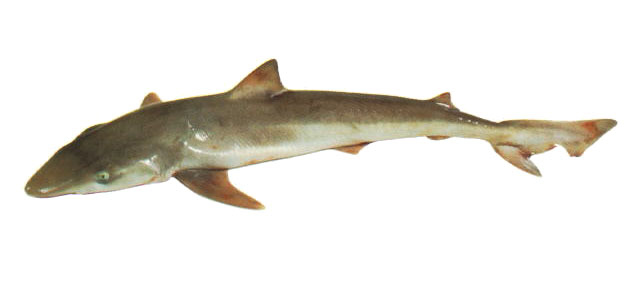| Triakidae (Houndsharks), subfamily: Galeorhininae |
| 193 cm TL (male/unsexed); 195 cm TL (female); max.weight: 45 kg; max. reported age: 55 years |
|
benthopelagic; marine; depth range 0 - 1100 m, oceanodromous |
| World-wide in temperate waters (Ref. 58085). Western Atlantic: southern Brazil to Argentina. Eastern Atlantic: Iceland, Norway, Faeroe Islands, British Isles to the Mediterranean and Senegal; Namibia to South Africa (Western Indian Ocean). Western Pacific: Australia and New Zealand. Eastern Pacific: British Columbia (Canada) to southern Baja California, Gulf of California; Peru and Chile. Questionable records in Ivory Coast, Nigerai, Gabon to Congo Dem Rep and Laysan Is. (Hawaii) (Ref 244). |
|
Dorsal spines (total): 0-0; Dorsal soft rays (total): 0-0; Anal spines: 0-0; Anal soft rays: 0-0. A large houndshark with a long, pointed snout, a large mouth, and small blade-like teeth; 2nd dorsal about as large as anal fin and terminal caudal lobe as long as rest of fin (Ref. 5578). Greyish above, white below; young with black markings on fins (Ref. 5578). |
| Mainly demersal on continental and insular shelves, but also on the upper slopes, at depths from near shore to 550 m (Ref. 6871), but has been shown to be pelagic in the open ocean (frequently caught on floating tuna longlines over deep water, and many New Zealand-tagged specimens have been recaptured in Australia) (Ref. 26346). Occurs in small schools that are highly migratory in higher latitudes in their range (Ref. 244). There is pronounced partial segregation by size and sex in some areas (Ref. 244). Feeds on fishes (bottom as well as pelagic species, Ref. 26346), crustaceans, cephalopods, worms, and echinoderms (Ref. 244). Ovoviviparous (Ref. 50449). Targeted for human consumption, liver for squalene oil, fins for soup (Ref. 244); also utilized as fishmeal (Ref. 13563). Marketed fresh, dried-salted, and frozen (Ref. 9987). Adapts well in captivity if carefully captured and handled (Ref. 12951). |
|
Critically Endangered (CR); Date assessed: 14 February 2020 (A2bd) Ref. (130435)
|
| harmless |
|
Distributed on the continental shelf and slope around southern Australia, from Houtman Abrolhos in Western Australia to Moreton Bay in southern Queensland, including Bass Strait, Tasmania, and Lord Howe I. The young are found in Port Sorell, the Pitt Water Estuary, Frederick Henry Bay and Georges Bay in Tasmania, and areas near Portarlington, Port Phillip Bay in Victoria, until late summer. Studies of movement of tagged school sharks across southern Australia suggests the presence of a single stock (Ref. 777). Commercial fishery: It is a major component of the Southern Shark Fishery which produces over 3000 t of sharks annually valued at up to AU$15 million to fishers in Victoria, Tasmania and South Australia. The catch is largely marketed in Victoria which began operating in offshore waters in the 1920s to meet the increasing demand for fresh shark fillets. About twenty years later, Tasmania and South Australia entered the school shark fishery. Before gillnets were introduced in 1964, shark fishers were using longlines up to 10 km long taking mostly school sharks. Gillnets of 6-inch mesh size are being used by Bass Strait fishers while 7-inch mesh size are utilized in South Australia. However, most Tasmanian fishers still use longlines. The school shark fishery peaked between 1969 and 1980, while fishing effort increased threefold as well. School sharks are very popular in the fish-and-chips trade. They are marketed fresh, chilled, headed and gutted. The flesh is sold mostly as 'flake'. In 1972, the sale of large volumes of school sharks was banned due to its high mercury content (Ref. 26064, 26065).
Recreational fishery: Recreational fishers take a small amount of school sharks using handlines, rod-and-line and gillnets (only in Tasmania), in ocean beaches and coastal bays. A 33.5 kg school shark was caught in South Australia and considered the largest taken by a recreational angler.
Resource status: Overfishing was evidenced by trends in catch per unit of effort and fishery simulation models. Assessments done in 1991 and 1992 concluded that school sharks are overexploited. Those found in Bass Strait have been particularly reduced in abundance. Sustainable yield estimates in 1993 were about 1200 t per annum (combined carcass weight of school and gummy sharks) which was less than half the 1993 catch of both species. However, this estimate is uncertain. Other fisheries such as trawling, offshore longlining, the bay-and-inlet fisheries in Victoria, Danish seining and the specialised gillnets used in the recreational fishery in Tasmania put a strain on the shark fishery as well. Also Ref. 244, 7300, 9987, 13563. |
Source and more info: www.fishbase.org. For personal, classroom, and other internal use only. Not for publication.

